- The Meaning of Critical Thinking: A Key Skill for Navigating Today’s Information Landscape - November 3, 2025
- Grandparents Can Develop Activist Grandchildren - September 29, 2025
- Top Six Reasons Credit Union Benefits Are a Smart Choice Over Banks - August 18, 2025
Last Updated on February 27, 2025
What do free speech and talking statues have in common?
I traveled on a lovely vegan tour of Italy and, as is typical for me, I especially enjoyed the sights off the beaten path. Yes, the Coliseum is impressive. Of course, the innumerable gilded Catholic Churches are awe-inspiring. But I found myself looking the other way, noticing the still-operating Roman sewer system, or Rome’s aptly-named umbrella trees.
Before I traveled, I watched a video about essential Italy, which featured sights I knew, such as the Roman Forum and the Venetian canals. But peppered through the video tour were tales of the enchanting Talking Statues and free speech. Because they are not famous or easy to find I assumed I would not see them. I was wrong.
The Talking Statues of Rome: A Conversation of Wits

One day we met at a piazza to go to dinner, I looked up, saw a mangled sculpture, and gasped. Turning to our tour guide, I blurted, “Is this a Talking Statue?”
I didn’t know my group that well yet and they may have thought I had been drinking all afternoon. But our tour guide confirmed it was, indeed, a Talking Statue.
“Which one?” I asked excitedly. I was thrilled to hear that I was gazing at Pasquino, the first Talking Statue of Rome. He championed free speech.
Pasquino, the First Talking Statue of Rome
Pasquino doesn’t look like much in real life. He didn’t look like much when, in 1501, construction workers dug him up and placed in the piazza. He is thought to be a mutilated statue of Menelaus holding a slain Patroclus.
Rome has a bajillion sculptures more impressive than Pasquino. But they don’t talk.
Because of the stranglehold of the church on Italian society, the Talking Statutes were a way for people to show displeasure with the church and the Popes. You could get in big trouble for speaking out against religious or civil leaders, so Pasquino used Latin poetry to get your message out. Sort of like a fake Twitter account.
How did Pasquino become a Talking Statue?
“One story of the origin of the statue’s name, and of its witticisms, is that it was named to honor a local resident named Pasquino. A tailor by trade (in some versions of the story he is a barber or schoolmaster), this man’s career took him into the Vatican, where he would learn behind-the-scenes gossip. He would then spread this gossip, with acerbic commentary, for the entertainment of friends and neighbors. Upon his death, the statue was named in his honor, and people began posting commentary similar to Pasquino’s on the statue.” (Wikipedia)
The Statues vs. The Popes
The popes, who Pasquino loved to criticize, tried to stop him. Pope Adrian VI, exasperated with Pasquino’s criticisms, wanted to throw him into the Tiber River. His advisors said that drowning Pasquino would only make him speak louder.
They tried passing laws to prevent him from free speech. This resulted in more poems.
Finally, they posted guards on Pasquino, which didn’t stop the Italians. They created five more Talking Statues.
Marfario
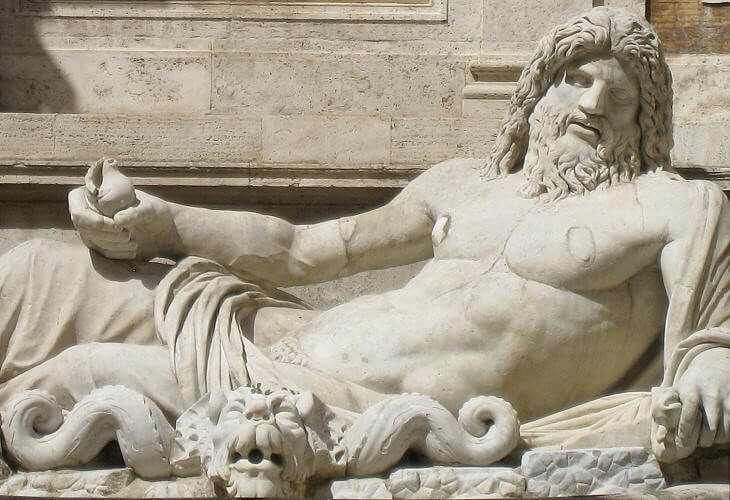
In better shape than Pasquino, Marfario is probably some form of water-god. He and Pasquino exchanged poems, having conversations with one another. After one Pope was spending too much time in his hometown of Urbino, Marforio asked, “What are you up to, Pasquino?”
Pasquino: “I’m watching over our city, to make sure it doesn’t get moved to Urbino!”
An effort to stop Marforio from talking was disguised as “art preservation.” Marfario was moved to a museum and thereafter, silenced.
[Like what you’ve read? Follow the blog so you don’t miss any content.]
Madame Lucrezia
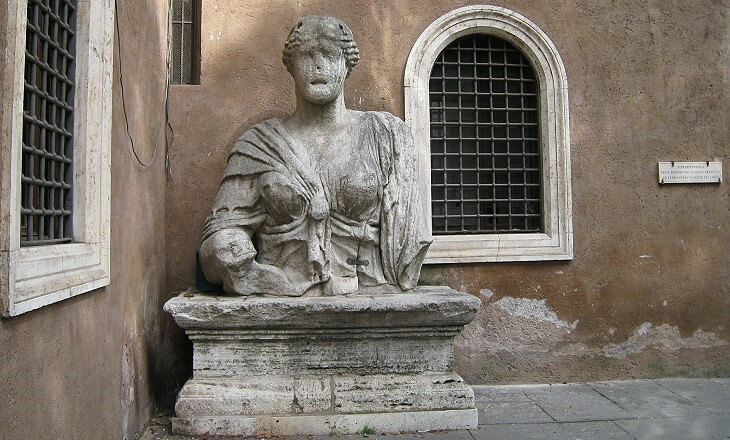
A large statue, Madame Lucrezia is possibly Isis. She is the only female talking statute and used to converse with Marfario, until he was imprisoned in the museum.
How did she come by her name?
“Her traditional name also has two possible origins: the more amusing one attributes her title to her resemblance to a certain well-endowed lady living in the neighbourhood nearby famous for her ‘hospitality’; the other more prosaic explanation (and sadly more likely to be correct) is that she was named after Lucrezia d’Alagno, the mistress of the king of Naples, who moved to Rome when he died, and that she simply owned the statue.”
Il Facchino: The Porter
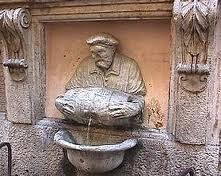
The Porter is a working fountain, created in 1580. Although having the title of porter, he is noted to be wearing the uniform of Renaissance water-sellers and is carrying a water cask.
One legend is that his face is mutilated because he resembled Martin Luther and moms told their kids to hit him with stones. Those Italian kids have excellent aim.
Abate Luigi: Father Louis
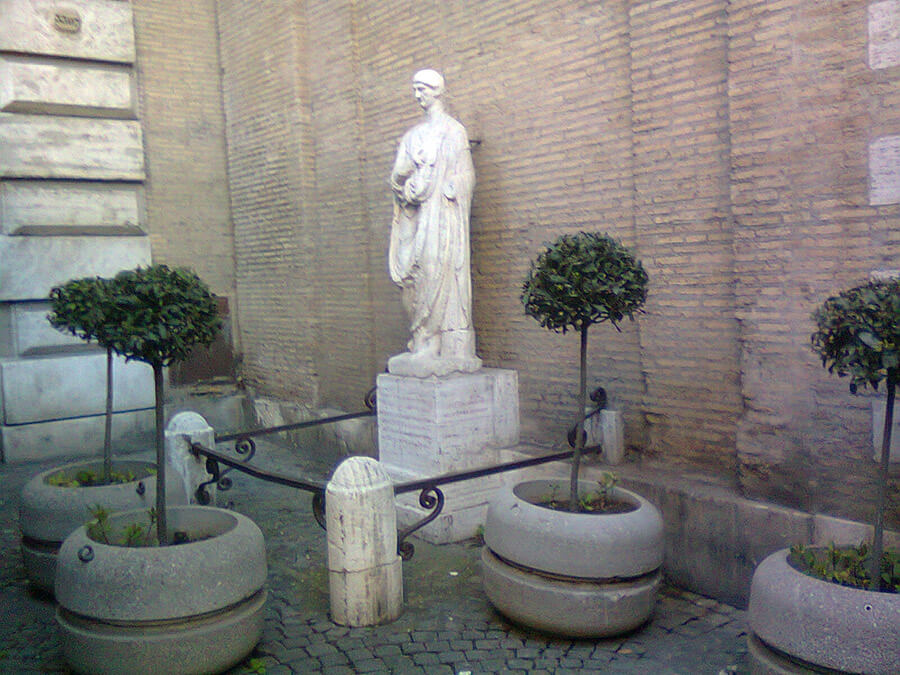
Father Louis is the statue of an unknown emperor; unknown because the head and body do not belong together. He is called Father Louis because he resembled one of the local clergymen.
The plaque near him has an inscription, translated as:
I was a citizen of ancient Rome
Now everybody calls me Abbot Louis.
With Marfario and Pasquino I won
Eternal fame with urban satire.
I received offences, mistreatment and burial.
But a new life here, safe at last.
Babuino (The Baboon)

The Baboon is a statue of the drunk Silenus or The Baboon. His name does not refer to a monkey; instead to a fool.
His head obviously does not match his body and he is placed behind a horse trough. But that did not stop his wit during Napoleon’s invasion:
Pasquino: “Are all Frenchmen thieves like this?”
Babuino: “Not all perhaps, but a good part of them are!” (good part in Italian is buona parte)
Pasquinades
Pasquino and his talking friends inspired the English word pasquinade, which means a lampoon in a public place or satirical writing.
The most well-known pasquinade was aimed at Pope Barberini in response to him taking materials from the Pantheon to decorate a church.
What the Barbarians did not do
the Barberini did.
Pope Barberini also heard from the statues when he imposed a bread tax to build a fountain:
We need other than fountain and spires heads,
Bread is what we want- bread, bread, bread.
Mussolini and Hitler got a message, too:
Cardboards and facades lined Roman streets
When a failed housepainter and fascist dictator meet.
Modern messages from Pasquino
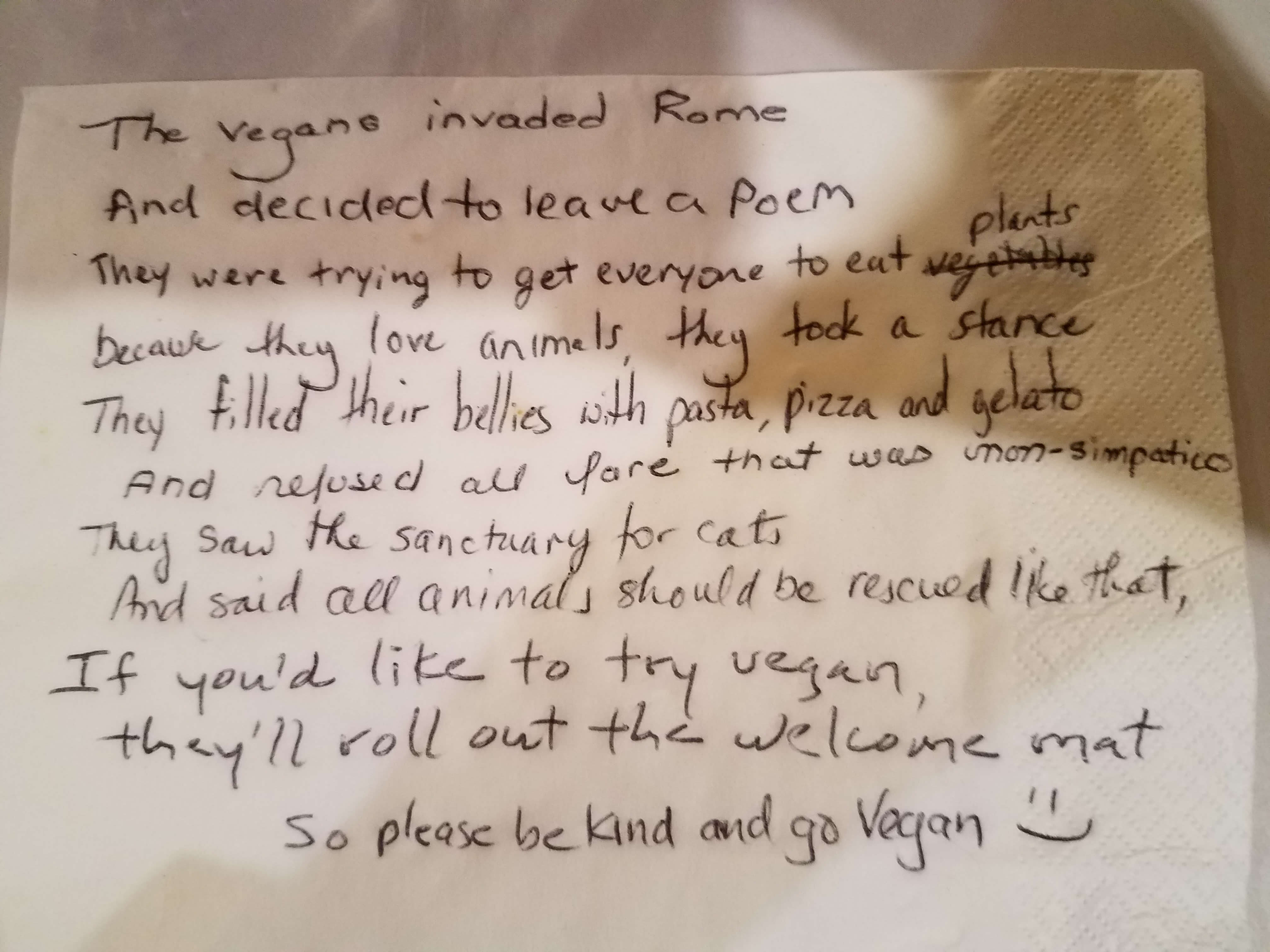
On his board, we were delighted that he had several pro-vegan messages. So we asked him to pen an English poem to honor our vegan tour group. Thanks, Pasquino!
[Start your activism journey today.]
READ NEXT
But wait, there are more free speech statues!
- At the Intersection of Free Speech and Art: The Talking Statues of Venice
- At the Intersection of Free Speech and Art: Bernini’s Elephant and Obelisk
My Big Fat Italian Veganfest (And My Small Skinny Scruffy City One)
How To Make Powerful Change In Your Activism
I’m Swamped! How Can a Slacktivist Make A Difference In The World?
Who was Cesar Chavez’s Surprisingly Badass Partner?
Browse more examples of artistic activism.





Pingback: At the Intersection of Free Speech and Art: Bernini's Elephant and Obelisk • Life At the Intersection
Neat story about Italian history. Thanks!
What a breathe of fresh air this article is! The Colosseum, Pompeii, the Leaning Tower of Pisa — those I’m familiar with. But the Talking Statues of Rome are off the beaten path. Thank you for this fun, enlightening piece.
Thanks, Trish. I hope you get to visit Rome some day.
I loved reading this. It was so interesting.
Glad you liked it! I just discovered that Pasquino talked to a statue in Venice, so I’m working on a post about that. I hope you’ll come back to read it.
Pingback: At the Intersection of Free Speech and Art: The Talking Statues of Venice • Life At the Intersection
Pingback: My Big Fat Italian VeganFest (and my Small Skinny Scruffy City one) • Life At the Intersection
Pingback: ~ Esme Salon
Pingback: Who Moved My Cheese? How To Travel With Compassion. • Life At the Intersection
Pingback: How to Use Artistic Activism to Change the World
I love these talking statues and will look out for them should I get to Italy. #SeniorSalon
Thanks for stopping by, Darlene. I hope you get to see the statues someday!
I throughly enjoyed this post. I hope to go to Italy one day…who knows I may never be allowed to again so if that happens I will read and visit through you xx #SeniorSalon
Italy is wonderful and I am rooting for you to go, Bree.
Pingback: Monday InLinkz Join us at 174 Senior Salon